Complete Solutions to QUESTION BANK of chapter QUESTION BANK of Class 9 book with complete answers and questions
| Class 9 | PHYSICS |
| Chapter | QUESTION BANK |
| BHARATI BHAWAN | QUESTION BANK |
| Number Of Questions | 51 |
| Academic Year | 2023-24 |
Two particles, A and B, move along the same straight line. At t=0, there velocities are zero. Look at their acceleration-time graphs and say whether the statements given below are true or false
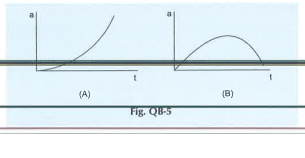
The velocity of each particle is continuously increasing.
View SolutionTwo particles, A and B, move along the same straight line. At t=0, there velocities are zero. Look at their acceleration-time graphs and say whether the statements given below are true or false
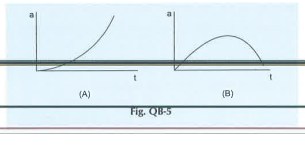
The velocity of each particle is continuously decreasing.
View SolutionTwo particles, A and B, move along the same straight line. At t=0, there velocities are zero. Look at their acceleration-time graphs and say whether the statements given below are true or false

The velocity of A increases continuously, but that of B decreases continuously.
View SolutionTwo particles, A and B, move along the same straight line. At t=0, there velocities are zero. Look at their acceleration-time graphs and say whether the statements given below are true or false
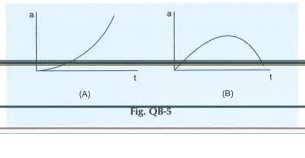
Both particles are moving in the same direction .
View SolutionTwo particles, A and B, move along the same straight line. At t=0, there velocities are zero. Look at their acceleration-time graphs and say whether the statements given below are true or false
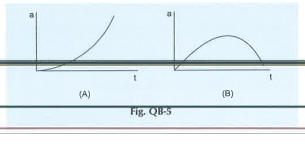
The velocity of B first increases and then decreases.
View SolutionTwo particles, A and B, move along the same straight line. At t=0, there velocities are zero. Look at their acceleration-time graphs and say whether the statements given below are true or false
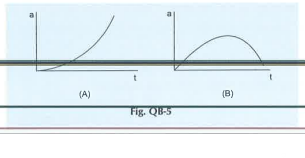
One can apply `x=1/2 at^2` for A, but not for B.
View SolutionWhich statement is correct ?
View SolutionTwo trains are moving at speeds 80 km/h and 100 km/h on parallel tracks in the same direction. From this information, one can say that
View SolutionA particle is moving along a straight line.
View SolutionThe distance-time graph of a particle moving along a curved path is a straight line .
View SolutionLook at the given distance -time graph of an object .
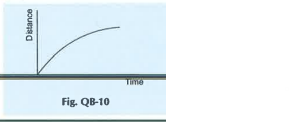
View SolutionA particle moves along a straight line. Its velocity and speed are denoted by `v_1` and `v_2`. The quantity `(v_1)/(v_2)`
View SolutionThree forces act on a particle and keep ai at rest. It is possible to have
View SolutionWhich of the following is a contact force ?
View SolutionNormal force always acts
View SolutionA heavy ball is dropped from a height on a pile of sand. After falling on the pile, the ball moves some distance in the sand and then stops. During its motion in the sand, the force `F_w` on the ball due to its weight and the force `F_5`due to sand
View SolutionConsider a cylindrical rod immersed in water in a vertical position. The force by the water on the rod is

View SolutionTo open the door of a room, you push on the handle, and to close it you pull on the handle. The work done you you on the handle is
View SolutionA sound wave is generated due to a vibrating tuning fork. The separation between a layer of maximum compression and the next layer of normal density is
View SolutionThe amplitude of density variation corresponding to a sound wave is `1 "milligram/metre"^3. The maximum difference in the density between different layers of air will be
View SolutionMark the statement True (T) or False (F):The magnitude of the velocity of an object is equal to its speed at that instant.
View SolutionMark the statement True (T) or False (F): The magnitude of the speed of an object is equal to its velocity at that instant.
View SolutionMark the statement True (T) or False (F):The velocity of a particle at an instant is -4 m/s. The particle must be moving along a straight line.
View SolutionMark the statement True (T) or False (F):The velocity of a particle at an instant is 4 m/s. The particle must be moving along a straight line.
View SolutionMark the statement True (T) or False (F): The position -time graph of a particle moving along a straight line in as shown in the figure. Its speed in constant.
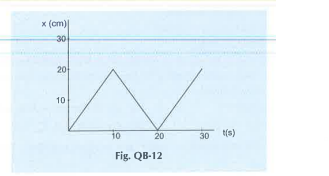
View SolutionMark the statement True (T) or False (F):A particle moves along a straight line. Its speed and velocity are both given by +3 m/s at an instant. The particle is moving the positive direction of the line .
View SolutionIf the acceleration of an object is not zero, its speed must be changing .
View SolutionIf the acceleration of an object is zero for a period, it cannot change its direction of motion during this period.
View SolutionAccelerations of two objects are `2.0 m//s^2` and `4.0 m//s^2` at an instant. It is possible that their speeds are equal at this instant.
View SolutionWhen a force acts on a body, its speed necessarily changes.
View SolutionForces can only be applied by living bodies.
View SolutionWhen you hold a bucket of water, you apply an upward force on the bucket, which is equal to the combined weight of the bucket and the water.
View SolutionIn action-reaction pair forces, action force acts before the reaction force.
View SolutionEqual forces acting on two different bodies always produce the same acceleration.
View SolutionWhen a steel rod is immersed in water, the force exerted by the water on the rod is equal to the weight of the red.
View SolutionWhen a plastic rod floats in water, the force exerted by the water on the rod is equal to the weight of the rod.
View SolutionWhen a plastic rod is completely immersed in water, the force exerted by the water on the rod is equal to the weight of the rod.
View SolutionAccording to the principle of conservation of energy, it the kinetic energy of an object is decreased by `50%`, Its potential energy will be increased by `50%`.
View SolutionA stone hits a glass plate, which breaks. When this happens, the density of the air around the plate changes.
View SolutionThe pitch of sound is measured in hertz.
View SolutionA 2-kHz sound will spread less around the edges of a cardboard as compared to a 1-kHz sound.
View SolutionA louder sound bends more more around the edges than a less-loud sound of the same frequency.
View SolutionThe allowed limit of arsenic in drinking water is 0.00005 grams per litre. Convert this into SI unit.
View SolutionThe radius of a hydrogen atom is `5.3xx 10^(-11)m`. Convert this into a unit with a standard prefix before metre so that the numerical value is between 1 and 1000.
View SolutionConvert 1 yard into metres.
View SolutionConvert 100 square yards into square metres.
View SolutionDelhi and chicago are almost diametrically opposite on the earth. If someone travels from Chicago to Delhi, what will be the magnitude of his displacement ?
View SolutionIn the hare and tortoise race, the tortoise ran at a uniform speed of 10 cm/s and reached the finishing line in 72 minutes. The hare ran at 1 m/s for the first 6 minutes and then slept for 65 minutes. He then ran at 1 m/s to reach the finishing line.When the hare went to sleep, what was the position of the tortoise ? What was the position of the hare at that time ?
View SolutionIn the hare and tortoise race, the tortoise ran at a uniform speed of 10 cm/s and reached the finishing line in 72 minutes. The hare ran at 1 m/s for the first 6 minutes and then slept for 65 minutes. He then ran at 1 m/s to reach the finishing line. After how much time after the start did the tortoise cross the hare ?
View SolutionThe velocity of a particle moving along a straight line varies with time as shown in the Figure. Find the total distance covered and the total displacement between 0 and 20 seconds.

View SolutionThe length of the outer edge of a cubical vessel is 10 cm and the length of its inner edge is 9.8 cm. If it is immersed in water just up to its full height without allowing water to enter the vessel. How much volume of water will it displace ?
View Solution
QUESTION BANK questions and complete solutions for chapter QUESTION BANK of HC VERMA of Class 9